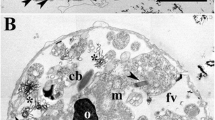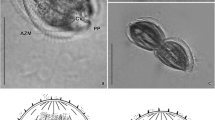Summary
The resting trichocysts of theCryptophyceae are composed of one or two cylindrical bodies with a conic excavation on both or one side, respectively, a central body, and a surrounding tripartite membrane. The cylindrical bodies are made up of a tape of slowly increasing width, 30–40 å in thickness, tightly rolled up in a spiral course. In two-membered trichocysts the cylindrical bodies are different in size, the proximal bigger than the distal one, the axes of which are standing oblique to one another.
Early stages of development of trichocysts exclusively are lying in close proximity to the single dictyosome, from which they can be derived. These stages are vesicles, 100–160 nm in diameter, containing a trichocyst tape of only a few turns, 20 å in thickness, and a central body. Preceding stages presumably are vesicles, 40–80 in diameter, with an electron opaque membrane and peripheral granules inside. In the course of the trichocyst development, the number of turns and the width of the coiled tape from the center to the periphery are increased. After passing an one-membered initial phase, the development of the second cylinder starts in some distance from the dictyosome, subsequently leading to two-membered trichocysts.
Normally the trichocysts are transported to the periphery, where they predominantly border the furrow-gullet-system of theCryptophyceae. Cytolysomes (secondary lysosomes) containing trichocyst material frequently have been found in the vicinity of the dictyosome; this observation supports the view of a decomposition of surplus trichocystsin vivo by lysosomes.
Zusammenfassung
Die Trichocysten der Cryptophyceen bestehen im Ruhezustand aus ein oder zwei zylindrischen Körpern mit einer konischen Aushöhlung auf beiden bzw. einer Seite, einem Zentralkörper und einer umgebenden dreischichtigen Membran. Die zylindrischen Körper sind aus einem Band mit langsam zunehmender Breite und 30–40 å Dicke in dichter spiraliger Aufrollung aufgebaut. In den zweigliedrigen Trichocysten sind die zylindrischen Körper von unterschiedlicher Grö\e, der proximale grö\er als der distale, ihre Achsen stehen schrÄg zueinander.
Frühstadien der Trichocystenentwicklung liegen ausschlie\lich in nÄchster NÄhe zu dem in Einzahl vorkommenden Dictyosom, von dem sie sich ableiten lassen; sie stellen BlÄschen von 100 bis 160 nm im Durchmesser dar, die ein Trichocystenband von 20 å Dicke mit nur wenigen UmlÄufen und einen Zentralkörper enthalten. Vorhergehende Stadien sind vermutlich BlÄschen von 40 bis 80 nm Durchmesser mit einer kontrastreichen Membran und körnigem, randlich liegendem Inhalt. Im Laufe der Trichocystenentwicklung nehmen die Zahl der UmlÄufe und die Bandbreite vom Zentrum zur Peripherie hin zu. Nach einer eingliedrigen Initialphase beginnt die Entwicklung des zweiten Zylinders in einiger Entfernung vom Dictyosom und führt damit zu zweigliedrigen Trichocysten. In der Regel werden die Trichocysten zur Peripherie verfrachtet, wo sie hauptsÄchlich das Furchen-Schlund-System der Cryptophyceen umsÄumen. Cytolysomen (sekundÄre Lysosomen) mit Trichocystenmaterial sind hÄufig in der NÄhe des Dictyosoms beobachtet worden; sie sprechen für einenin vivo Abbau überschüssiger Trichocysten in Lysosomen.
Similar content being viewed by others
Literatur
Anderson, E., 1962: A cytological study ofChilomonas paramecium with particular reference to the so-called trichocysts. J. Protozool.9, 380–395.
Beams, H. W., andR. G. Kessel, 1968: The Golgi apparatus — structure and function. Int. Rev. Cytol.23, 209–276.
Bonnet, H. T., Jr., andE. H. Newcomb, 1966: Coated vesicles and other cytoplasmic components of growing root hairs of radish. Protoplasma62, 59–75.
Bouck, G. B., andB. M. Sweeney, 1966: The fine structure and ontogeney of trichocysts in marine dinoflagellates. Protoplasma61, 205–223.
Brandes, D., andF. Bertini, 1964: Role of Golgi apparatus in the formation of cytolysomes. Exp. Cell Res.35, 194–217.
—,D. E. Buetow, F. Bertini, andD. B. Malkoff, 1964: Role of lysosomes in cellular lytic processes. I. Effect of carbon starvation inEuglena gracilis. Exp. mol. Pathol.3, 583–609.
Butcher, R. W., 1967.: An introductory account of the smaller algae of British coastal waters. Part IV.Cryptophyceae. London: H.M.S.O.
De Duve, C., 1963: The lysosome. Sci. Amer.208 5, 64–72.
—, 1967: Lysosomes and phagosomes. The vacuolar apparatus. Protoplasma63, 95–98.
—, 1966: Functions of lysosomes. Ann. Rev. Physiol.28, 435–492.
Dodge, J. D., 1969: The ultrastructure ofChroomonas mesostigmatica Butcher (Cryptophyceae). Arch. Mikrobiol.69, 266–280.
Dragesco, J., 1951: Sur la structure des trichocystes du Flagellé cryptomonadineChilomonas paramecium. Bull. Micr. appl.1, 172–175.
—,G. Auderset etM. Baumann, 1965: Observations sur la structure et la genèse des trichocystes toxiques et des protrichocystes deDileptus (Ciliés, Holotriches). Protistologica1, 81–90.
Ehret, C. L., andG. de Haller, 1963: Origin, development, and maturation of organelles and organelle system of the cell surface inParamecium. J. Ultrastruct. Res.6 suppl., 1–44.
Goldfischer, S., E. Essner, andA. B. Novikoff, 1964: The localization of phosphatase activities at the level of ultrastructure. J. Histochem. Cytochem.12, 72–95.
Grell, K. G., 1968: Protozoologie, 2. Aufl., Berlin-Heidelberg-New York: Springer-Verlag.
Hollande, A., 1952: Classe des Cryptomonadines. In:P. P. Grasse: Traité de Zoologie1, 285–308. Paris: Masson éd.
Hovasse, R., 1965: Trichocystes, corps trichocystoides, cnidocystes et colloblastes. ProtoplasmatologiaIII, F 1–57. Wien-New York: Springer-Verlag.
—,J. P. Mignot etL. Joyon, 1967: Nouvelle observations sur les trichocystes des Cryptomonadines et les ≪ R bodies ≫ des particules kappa deParamecium aurelia Killer. Protistologica3, 241–255.
Joyon, L., 1963: Contribution à l'étude cytologique de quelques protozoires flagellés. Ann. Fac. Sci. Univ. Clermont No. 22, Biol. Animale1, 1–96.
Koch, W., 1964: Verzeichnis der Sammlung von Algenkulturen am Pflanzenphysiologischen Institut der UniversitÄt Göttingen. Arch. Mikrobiol.47, 402–432.
Manton, I., 1966 a: Observations on scale production inPrymnesium parvum. J. Cell Sci.1, 375–380.
—, 1966 b: Observations on scale production inPyramimonas amylifera Conrad. J. Cell Sci.1, 429–438.
—, 1967: Further observations on scale formation inChrysochromulina chiton. J. Cell Sci.2, 411–418.
—,D. Rayns, H. Ettl, andM. Parke, 1965: Further observations on green flagellates with scaly flagella: the genusHeteromastix Korshikov. J. mar. biol. Ass. U.K.45, 241–255.
—, andH. Ettl, 1965: Observations on the fine structure ofMesostigma viride Lauterborn. J. Linn. Soc.59, 175–184.
Mignot, J. P., 1963: Quelques particularités de l'ultrastructure d'Entosiphon sulcatum (Duj.) Stein (Flagellé Euglénien). C. R. Acad. Sci.257, 2530–2533.
—, 1965: Etude ultrastructurale deCyathomonas truncata From. (Flagellé Cryptomonadine). J. Microscopie4, 239–252.
—, 1967: Structure et ultrastructure de quelques Chloromonadines. Protistologica3, 5–23.
Moe, H., J. Rostgaard, andO. Behnke, 1965: On the morphology and origin of virgin lysosomes in the intestinal epithelium of the rat. J. Ultrastruct. Res.12, 396–403.
Newcomb, E. H., 1967: A spiny vesicle in slime-producing cells of the bean root. J. Cell Biol.35, C 17-C 22.
Novikoff, A. B., andE. Essner, 1962: Cytolysomes and mitochondrial degeneration. J. Cell Biol.15, 140–146.
Parke, M., andI. Manton, 1965: Preliminary observations on the fine structure ofPrasinocladus marinus. J. mar. biol. Ass. U.K.45, 525–536.
Pascher, A., 1913:Cryptomonadinae. Sü\wasserflora, Heft 2,Flagellatae II, 96–114. Jena: G. Fischer-Verlag.
Penard, E., 1921: Studies on some Flagellata. Proc. nat. Acad. Sci. (Philadelphia)73, 105–168.
Poux, N., 1963: Sur la présence d'enclaves cytoplasmatiques en voie de dégénérescence dans les vacuoles des cellules végétales. C. R. Acad. Sci. (Paris)257, 736–738.
Pringsheim, E. G., 1944: Some aspects of taxonomy in theCryptophyceae. New Phytologist43, 143–150.
Robertson, J. D., 1960: A molecular theory of cell membrane structure. 4. Internat. Kongre\ für Elektronenmikroskopie,2, 159–171. Berlin-Göttingen-Heidelberg: Springer-Verlag.
Schnepf, E., undG. DeichgrÄber, 1969: über die Feinstruktur vonSynura petersenii unter besonderer Berücksichtigung der Morphogenese ihrer Kieselschuppen. Protoplasma68, 85–106.
Schuster, F. L., 1968: The gullet and trichocysts ofCyathomonas truncata. Exp. Cell Res.49, 277–284.
Sievers, A., 1966: Lysosomen-Ähnliche Kompartimente in Pflanzenzellen. Naturwiss.53, 334–335.
—, 1967: Elektronenmikroskopische Untersuchungen zur geotropischen Reaktion II. Die polare Organisation des normal wachsenden Rhizoids vonChara foetida. Protoplasma64, 225–253.
Sitte, P., 1961: Die submikroskopische Organisation der Pflanzenzelle. Ber. deutsch, bot. Ges.74, 177–206.
Smith, R. E., andM. G. Farquhar, 1966: Lysosome function in the regulation of the secretory process in cells of the anterior pituitary gland. J. Cell Biol.31, 319–347.
Villiers, T. A., 1967: Cytolysomes in long-dormant plant embryo cells. Nature (London)214, 1356–1357.
Wehrmeyer, W., 1970: Zur Feinstruktur der Chloroplasten einiger photoautotropher Cryptophyceen. Arch. Mikrobiol.71, 367–383.
Wessenberg, H., andG. Antipa, 1968: Studies onDidinium nasutum I. Structure and ultrastructure. Protistologica4, 427–447.
Yusa, A., 1962: Electron microscopical observations on developing trichocysts inParamecium caudatum. J. Protozool.9 suppl., 6.
—, 1963: An electron microscope study on regeneration of trichocysts inParamecium caudatum. J. Protozool.10, 253–262.
—, 1965: Fine structure of developing and mature trichocysts inFrontonia vesiculosa. J. Protozool.12, 51–60.
Author information
Authors and Affiliations
Additional information
Herrn Professor Dr. H.Drawert zum 60. Geburtstag gewidmet.
Für ihre unermüdliche, zuverlÄssige Mitarbeit danke ich FrauChrista Zimmermann und FrÄulein Christel Schlemonat. Der Deutschen Forschungsgemeinschaft bin ich für eine Sachbeihilfe zu Dank verpflichtet.
Rights and permissions
About this article
Cite this article
Wehrmeyer, W. Struktur, Entwicklung und Abbau von Trichocysten inCryptomonas undHemiselmis (Cryptophyceae) . Protoplasma 70, 295–315 (1970). https://doi.org/10.1007/BF01275759
Received:
Issue Date:
DOI: https://doi.org/10.1007/BF01275759




